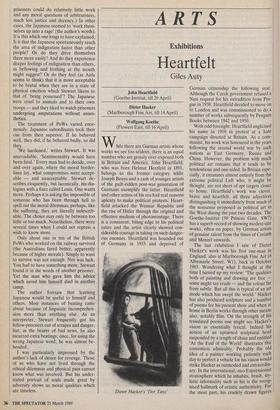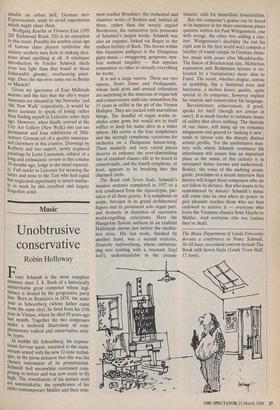ARTS
Exhibitions
Heartfelt
Giles Auty
John Heartfield (Goethe-Institut, till 20 April) Dieter Hacker (Marlborough Fine Art, till 14 April) Wolfgang Koethe (Flowers East, till 16 April)
While there are Gorman artists whose works we see too seldom, there is an equal number who are grossly over-exposed both in Britain and America. John Heartfield, who was born Helmut Herzfeld in 1891, belongs to the former category while Joseph Beuys and a rash of younger artists of the guilt-ridden post-war generation of Germans exemplify the latter. Heartfield and other artists of his era had real reasons aplenty to make political protests. Heart- field attacked the Weimar Republic and the rise of Hitler through the original and effective medium of photomontage. There is a consistent, biting edge to his political satire and the artist clearly showed con- siderable courage in taking on such danger- ous enemies. Heartfield was hounded out of Germany in 1933 and deprived of Dieter Hacker's Der Tanz' German citizenship the following year. Although the Czech government refused a Nazi request for his extradition from Pra- gue in 1938, Heartfield decided to move on to London and was commissioned to do a number of works subsequently by Penguin Books between 1942 and 1950.
With odd foresight, Heartfield anglicised his name in 1916 in protest at a hate campaign directed at Britain. As a com- munist, his work was honoured in the years following the second world war by such nations as East Germany, Russia and China. However, the problem with much political art remains that it tends to be tendentious and one-sided. In Britain espe- cially, it emanates almost entirely from the extreme political Left who, it might be thought, are not short of apt targets closer to home. Heartfield's work was clever, brave and heartfelt, all three adjectives distinguishing it immediately from much of the nonsense proposed as political art in the West during the past two decades. The Goethe-Institut (50 Princes Gate, SW7) has a superb record of showing modest-size works, often on paper, by German artists of genuine talent from the times of Corinth and Menzel onwards.
The last exhibition I saw of Dieter Hacker's work was his first one-man in England, also at Marlborough Fine Art (6 Albemarle Street, W1), back in October 1985. Wondering what I thought at the time I turned up my review: 'The qualities both of painting and drawing are free — some might say crude — and the colour far from subtle. But all this is typical of an art mode which has swept the world.' Hacker has also produced sculpture and a number of poems for his present show and when at home in Berlin works through other means also, notably film. On the strength of his translated poems one might see Hacker:s vision as essentially lyrical. Indeed his notion of an upturned sculptural head suspended by a length of chain and entitled 'At the End of the World' illustrates this contention admirably. Probably the old idea of a painter working patiently each day to perfect a vehicle for his vision would strike Hacker as outmoded and extraordin- ary. In the international, neo-Expressionist stratosphere which he inhabits, brash, sty- listic informality such as his is the recog- nised hallmark of artistic authenticity. For the most part, his crudely drawn figures inhabit an urban hell; German neo- Expressionists seem to avoid experiences Which might cheer them.
Wolfgang Koethe at Flowers East (199/ 205 Richmond Road, E8) is no exception to this trend. Possibly his sombre close-ups of famous chess players symbolise the anxiety modern man feels in making deci- sions about anything at all. A catalogue introduction by Frieder Schnock sheds even less light than that found in these fashionably gloomy, overbearing paint- ings. Does the sun ever come out in Berlin or Munich?
Given my ignorance of East Midlands accents and the fact that the city's major museums are situated in 'the Newarke' and 'the New Walk' respectively, it would be more accurate to speak of losing rather than finding myself in Leicester some days ago. However, when finally arrived at the City Art Gallery (New Walk) one can see permanent and loan exhibitions of 20th- century German art of a quality unsurpas- sed elsewhere in this country. Drawings by Kollwitz and two superb, newly acquired Paintings by Lotte Laserstein, subject of a long and enthusiastic review in this column 18 months ago, lodge in the mind especial- ly. Full marks to Leicester for securing the latter and none to the Tate who had equal but neglected opportunity to invest similar- 'Y in work by this excellent and largely forgotten artist.



















































 Previous page
Previous page